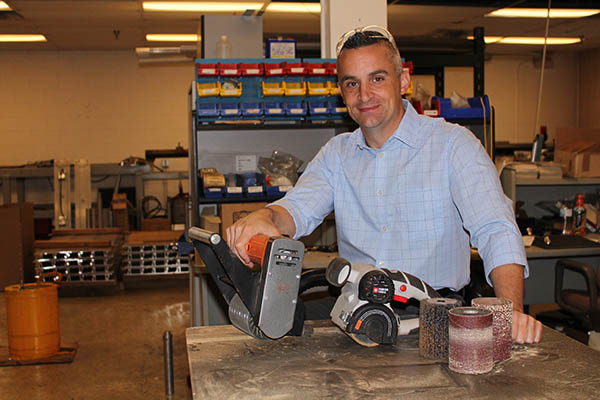
While Robert Kundel, Jr., doesn’t consider himself a woodworker at all, his invention, the Restorer tool, has several applications in woodworking – and a fascinating backstory.
Robert’s “day job” is the manager of the crane division, Kundel Cranes, for the family business, Kundel Industries, where he works with his dad, three brothers and a sister. They build cranes for projects all over the world (you might have heard of some their clients, like Ford, Uber and Tesla).
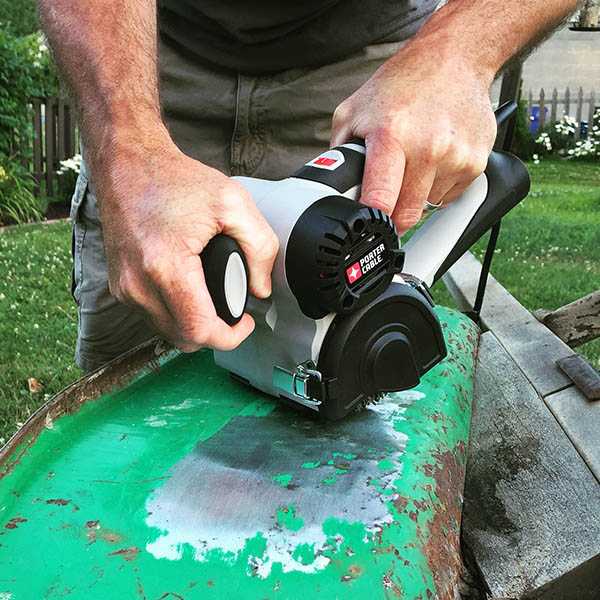
Robert got frustrated with trying to clean up dirt and grime, including rust, while getting around the corners, beams and pipes on the cranes under construction. They needed to be cleaned up before welding or painting. He thought there had to be a better way to do it, so “I went home and took my wife’s Dirt Devil® vacuum and took it apart. I originally thought I would just put rollers on a Dirt Devil” to create a handheld surface prep tool. That didn’t work.
So, in search of a cheap power supply, Robert purchased a $20 angle grinder from Harbor Freight, ripped its gearbox off, and installed it on a metal frame fabricated by fellow employee and former Delphi Electric tool and die maker Rich Schley. That kind of early version of the Restorer tool “worked amazing on metal,” Robert said. And, while he doesn’t call himself a woodworker, he does say, “I’m a DIY guy.” He had built his own wooden patio, which needed refinishing every year after being exposed to the elements in Ohio. In order to tackle the flaking wood on his patio, Robert decided to bring his tool home and try it out.
“I used it on my patio hand railing, and it stripped it down in seconds to brand-new wood,” Robert said.
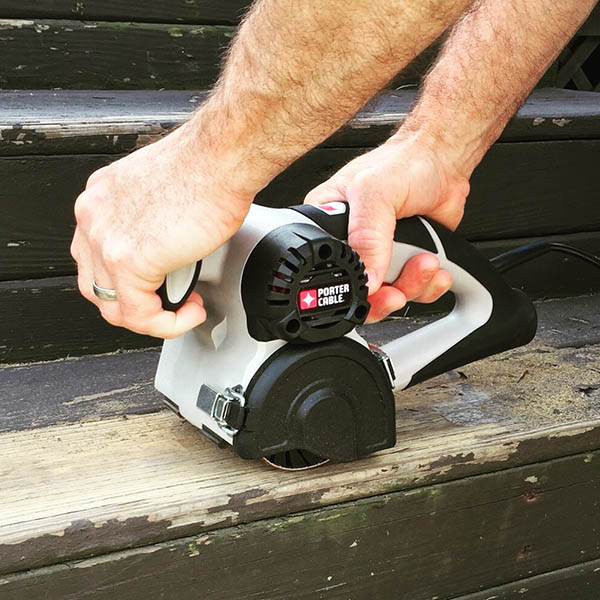
At this point, Robert started to think the tool could have broader applications. Unlike a belt sander, for instance, which “is so wide that it heats up the surface and makes paint gummy so that it sticks to the sandpaper, and ruins your abrasive,” the Restorer, on the other hand, “tends to flick material off: it works like a truck tire would throw mud,” Robert said. The surface stays cool, which preserves abrasives. Rather than digging in to a work surface, the Restorer floats above it. “The harder you push in, the deeper you go,” Robert said.
He noted that it has uses for sanding paint and other debris off reclaimed wood; plus sculpting freeform edges. “It’s not just a sanding tool,” though. “You can put any rollers in it you want. Any roller you put in, you change the applications of the tool” – whether that’s for sanding, buffing, surface grinding, or whatever else is to come.

Robert could see the possibilities in his tool, and started taking prototypes with him to trade shows he was attending as a representative of Kundel Cranes. Early on, he got some interest from a representative of FEIN Power Tools, who happened to be assigned the booth next door to his at a trade show. As a result of that contact, he sent a prototype of the Restorer to FEIN’s headquarters in Germany. The result, a while later, was a licensing offer that Robert declined because he felt the offer was too small.
After that, Robert met with Ridge Tool, the plumbing tool division of RIDGID tools on another invention of his, a plumbing wrench. There was interest there, too – but, after two years, the RIDGID brand manufactured by Techtronic Industries, which sells its tools via Home Depot, couldn’t get the retail price of the Restorer down to a level that the big box store would accept.
Robert had patented the Restorer and started his own separate company, Wellington Corp LLC, as the business entity responsible for the tool. He also had interest from end users in the tool, including some military use interested in using it to battle the high costs of corrosion. So, despite his difficulties bringing it to the large tool companies, Robert decided, “I’m going to make it,” and take on the manufacturing of the tool himself.
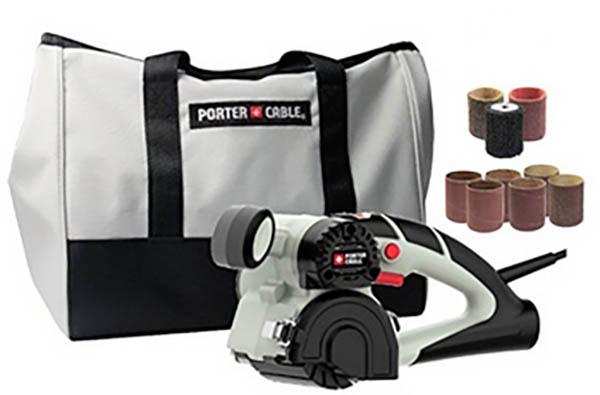
After making that decision, he connected with Matt Gennari of Gennari Consulting. Matt was a former employee of Black+Decker who now works with tool manufacturing company Jinding Electric Tools. Through this connection, as well as one made through business social networking site LinkedIn with John Cunningham – former president of consumer products at Stanley/Black+Decker and now president of License to Innovate, an agency that connects ideas and inventors with brands and markets – Robert finally made connections that led to the current status of the Restorer as a licensed product of the PORTER-CABLE (one of the divisions of Stanley/Black+Decker) brand.
That means, Robert said, that the Restorer goes through all of PORTER-CABLE’s regular product testing; “everything is tested and approved by the PORTER-CABLE team. You have to have good brand alignment to get retail space. ‘Kundel’ wouldn’t get good recognition.”
Robert’s now-small team (himself, Matt Gennari of Gennari Consulting; and Ned Cox, formerly with WORX and Rockwell Tool companies) have the right to use the PORTER-CABLE brand name as they sell the Restorer tool into retail locations; in return, the larger tool company gets a royalty for products sold.
The Restorer went on sale at Lowe’s® and Amazon in the last couple of months of 2016, with over 13,000 units sold to Lowe’s. It’s available at price points between $99 and $149, depending on the kit – currently sanding sleeves are available in different grits, plus a rust and paint remover wheel, and one version of the kit offers a tool carrying bag.
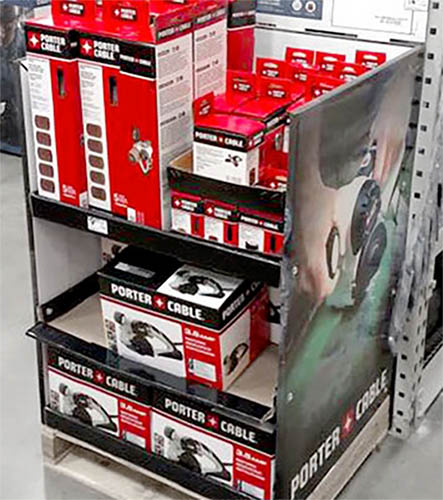
While many consumers walk by the tool on shelves, not knowing what it does, those who do purchase are excited about it and about future possibilities, Robert said. One customer posted a video of his wife using it to sand down floors – “you can attach it to your shop vac, so you can sand in your home and it won’t leave any debris.” He gets frequent inquiries about what’s coming next – a question partially answered under the “Restorer” tab at www.wellingtontool.com, which indicates what the company is working on. “I get to test samples, like a buffer, or a wire wheel, and try new accessories, and see how they work,” Robert said.

From invention of the tool to getting it on store shelves has taken about seven years. In the midst of this, Robert had an idea for directing the profits from the sale of the tool: “My goal is to make a retreat center for pastors,” he said. Still in the conceptual stage, the retreat center would be located in the vicinity of Charlotte, North Carolina and serve 50 to 100 pastors at a time as a place for them to come for restoration when they are facing burnout.
“We all have certain gifts and talents from God, and he gave me these,” Robert said. “I consider myself a solutions guy. The tool is called the Restorer; the retreat center is for restoration; and it says in the Bible [Isaiah 58:12] that Jesus is our Restorer. It all goes hand-in-hand.”





